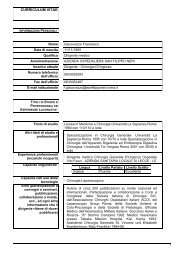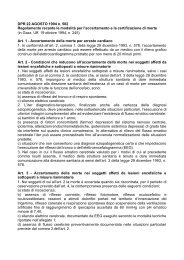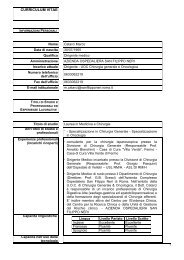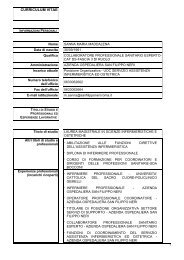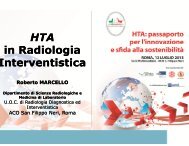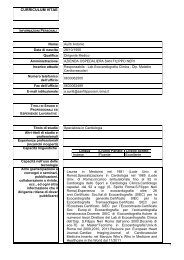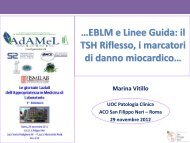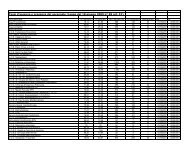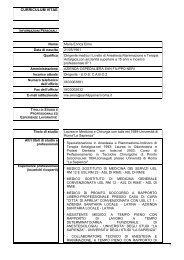LA CEUS NELLA PATOLOGIA PANCREATICA Carla Serra
LA CEUS NELLA PATOLOGIA PANCREATICA Carla Serra
LA CEUS NELLA PATOLOGIA PANCREATICA Carla Serra
Create successful ePaper yourself
Turn your PDF publications into a flip-book with our unique Google optimized e-Paper software.
<strong>LA</strong> <strong>CEUS</strong> NEL<strong>LA</strong><br />
<strong>PATOLOGIA</strong> <strong>PANCREATICA</strong><br />
<strong>Carla</strong> <strong>Serra</strong><br />
Dipartimento di Malattie Apparato Digerente<br />
e Medicina Interna<br />
Policlinico S.Orsola-Malpighi<br />
Bologna
IL RUOLO DELL’IMAGIN NELLE MA<strong>LA</strong>TTIE PANCREATICHE<br />
Rilevare la presenza<br />
In caso di identificazione del tumore evidenziare la malattia<br />
localmente avanzata<br />
Identificare i pazienti con metastassi<br />
TAC GOLD STANDARD PER LE LESIONI SOLIDE<br />
RM GOLD STANDARD PER LESIONI CISTICHE<br />
US E’ SPESSO <strong>LA</strong> PRIMA TECNICA DI IMMAGINE
US e PANCREAS<br />
Visualizzare la lesione<br />
Evidenziare gli effetti sul restante parenchima<br />
Mostrare il coinvolgimento di vasi,organi adiacenti<br />
Visualizzare metastasi epatiche
US<br />
B-Mode color-power-Doppler Doppler pulsato<br />
Contrast enhanced sonography<br />
MA<strong>LA</strong>TTIE PANCREATICHE<br />
IDENTIFICAZIONE<br />
STADIAZIONE<br />
DIAGNOSI ISTOLOGICA<br />
TRATTAMENTI
IL RUOLO DEL<strong>LA</strong> <strong>CEUS</strong> NELLE MA<strong>LA</strong>TTIE PANCREATICHE<br />
Non e’ indicata per la detection di lesioni ma<br />
per caratterizzare le lesioni identificate<br />
ecograficamente sia solide che liquide
<strong>CEUS</strong> e PANCREAS<br />
ALTA SENSIBILITA’ e SPECIFICITA’ NELL’EVIDENZIARE<br />
L’ANGIOGENESI
-Fase arteriosa precoce (10 - 30 sec)<br />
-Fase venosa (30 - 120 sec).<br />
-OBIETTIVI:<br />
PROCEDURA DI STUDIO<br />
Caratterizzazione delle masse pancreatiche<br />
Valutazione dei rapporti con i vasi adiiacenti<br />
Valutazione del fegato per ricerca metastasi
<strong>PATOLOGIA</strong> INFIAMMATORIA
PANCREATITE ACUTA<br />
COME AIUTA <strong>LA</strong> <strong>CEUS</strong>?<br />
Le pancreatiti acute focali anche<br />
quando supportate dai dati clinici<br />
possono creare probemi di diagnosi<br />
differenziale con lesioni neoplastiche
PANCREATITE ACUTA LIEVE<br />
-Ipoecogenicita’ omogenea di una ghiandola aumentata di<br />
dimensioni
PANCREATITE ACUTA LIEVE<br />
Hypervascularization after the administration of contrast<br />
agent, with different degrees of enhancement, resulting in an<br />
increased echogenicity in the dynamic phases
PANCREATITE ACUTA SEVERA<br />
IL CONTRIBUTO <strong>CEUS</strong><br />
<strong>CEUS</strong> permette di evidenziare le aree necrotiche e delimitarne<br />
la estensione<br />
Le aree necrotiche appaiono completamente anecogene,<br />
avascolari<br />
TAC rimane il GOLD STANDARD<br />
<strong>CEUS</strong> nel follow-up
Differentiation of vascular (solid) from avascular (liquid/necrotic)<br />
components of a lesion. (Recommendation Level: A;1b)<br />
Defining the dimensions and margins of a lesion, including its<br />
relationship with adjacent vessels. (Recommendation Level:<br />
B;2b)<br />
If the pancreatic region is clearly visible on US, <strong>CEUS</strong> can be<br />
used in the follow-up of acute pancreatitis after CT staging, in order<br />
to reduce the number of CT examinations
PSEUDOCISTI<br />
Conseguenza di una PA severa o di<br />
pancreatite cronica<br />
DD tumori cisti pancreatici in particolare il<br />
cistoadenoma mucinoso<br />
Approccio terapeutico diverso
Contenuto corpuscolato e disomogeneo alla US
PSEUDOCISTI<br />
<strong>CEUS</strong> ha un ruolo cruciale nella DD tra pseudocisti e tumori<br />
cistici pancreatici perche’ permette di evidenziare la<br />
vascularizzazione degli inclusi
Pseudocisti avascolari, anecogene alla <strong>CEUS</strong>
- Storia di PC<br />
PANCREATITI CRONICHE FOCALI<br />
- DD con l’adenocarcinoma duttale difficile perche’ entrambi ipoecogeni<br />
alla US
PANCREATITI CRONICHE FOCALI
PANCREATITI CRONICHE FOCALI<br />
<strong>CEUS</strong>: enhancement identico al parenchima circostante
PANCREATITI CRONICHE FOCALI<br />
Nelle forme crooniche di lunga durata puo’ essere presente<br />
ipovascolarizzazione per la prevalente componente fibrotica e la DD<br />
risulta difficile
PANCREATITI AUTOIMMUNI<br />
Forma di PC caratterizzata da flogosi periduttale sostenuta da<br />
infiltrazione di linfociti con evoluzione fibrotica<br />
US simile alla pancreatite focale anche se e’ piu’ frequente il<br />
coinvolgimento di tutta la ghiandola<br />
- ingrandimento del pancreas<br />
- ipoecogeno<br />
- compressione del dotto pancreatico maggiore
PANCREATITE AUTOIMMUNE<br />
RUOLO DEL<strong>LA</strong> <strong>CEUS</strong><br />
Enhancement moderato o intenso disomogeneo seguito da lento washout<br />
Vasi sottili per la infiltrazione linfocitaria e fibrosi.<br />
IMPORTANZA DELL <strong>CEUS</strong> DD con l’adenocarcinoma duttale
US E TUMORI PANCREATICI<br />
PUO’ <strong>LA</strong> <strong>CEUS</strong> AUMENTARE <strong>LA</strong> DETECTION?<br />
<strong>LA</strong> DETECTION E’ US 57- 81%<br />
Lesions < 1 cm<br />
Potter MW, Surg Oncol 2000
US e CARTATTERIZZAZIONE LESIONI PANCREATICHE<br />
Lesioni pancreatiche DD<br />
Adenocarcinoma T. Neuroendocrino<br />
Pancreatite cronica
ADENOCARCINOMA DUTTALE<br />
COLOR-DOPPLER<br />
Coinvolgimento vascolare –possibilita’ chirurgiche<br />
CARATTERIZZAZIONE ?
1. Characterisation of ductal adenocarcinoma. (Recommendation<br />
Level: A;1b)<br />
2. Defining the dimensions and margins of a lesion, including its<br />
relationship with adjacent vessels. (Recommendation Level:<br />
B;2b)
ADENOCARCINOMA DUTTALE<br />
<strong>CEUS</strong><br />
Scarso o assente enhancement
TUMORI NEUROENDOCRINI
TECNICHE QUANTITATIVE
ADENOCARCINOMA DUTTALE<br />
<strong>CEUS</strong> e STADIAZIONE<br />
Invasione locale (coinvolgimento tessuti<br />
circostanti)<br />
Metastasis (Fegato- linfonodi-peritoneo)
Pancreas. 2008 Oct;37(3):265-8.<br />
Resectable pancreatic adenocarcinoma: depiction of<br />
tumoral margins at contrast-enhanced ultrasonography.<br />
Faccioli N, D'Onofrio M, Malagò R, Zamboni G,<br />
Falconi M, Capelli P, Mucelli RP.
RESULTATI<br />
86 pancreatic masses<br />
Sensitivity<br />
VP/(VP+FN) 100%<br />
Specificity<br />
VN/(VN+FP) 85%<br />
PPV<br />
VP/(VP+FP) 95%<br />
NPV<br />
VN/(VN+FN) 100%
ADENOCARCINOMA DUTTALE<br />
STADIAZIONE<br />
Coinvolgimento vascolare
ADENOCARCINOMA DUTTALE<br />
STADIAZIONE<br />
METASTASI EPATICHE
<strong>CEUS</strong> puo’ mostrare lesioni < 1 cm
METASTASI PANCREATICHE<br />
Rare; le piu’ comuni da CA renale<br />
<strong>CEUS</strong> ipervascolare la DD e’ con le forme<br />
neuroendocrine<br />
Storia clinica, sintomi, biopsia
CISTOADENOMA SIEROSO<br />
Lesione benigna spesso solitario senza comunicazione con il dotto<br />
pancreatico. Aspetto microcistico con setti vascolarizzati<br />
Nel 15% cicatrice ccentrale
<strong>CEUS</strong> aumenta la caratterizzazione del tumore sieroso per la<br />
dimostrazione della vascolarizzazione dei setti e la migliore<br />
visualizzazione delle piccole cisti
Originano da:<br />
TUMORI PRODUCENTI MUCINA<br />
- Dotti periferici (tumori cistici mucinosi)<br />
- Dotto principale e dai suoi dotti collaterali<br />
neoplasia papillare intraduttale mucinosa<br />
(IPMN)
TUMORE CISTICO MUCINOSO<br />
Lesione potenzialmente maligna cistadenocarcinoma<br />
Imaging guida l’approccio terapeutico<br />
Lesione singola rotondeggiante nel corpo-cosa senza<br />
comunicazione con il Wirsung.<br />
Spesso grande e multiloculare, talora uniloculare con<br />
contenuto denso (mucina) e f parete spessa e irregolare e<br />
setti interni
TUMORE CISTICO MUCINOSO
La trasformazione maligna in cistadenocarcinoma e’ caratterizzato da<br />
noduli parietali vascolarizzati.<br />
<strong>CEUS</strong> DD tra pseudociti e tumore cistico mucinoso<br />
INCLUSI VASCO<strong>LA</strong>RIZZATI
Tumore cistico in aumento<br />
IPMN<br />
Origine e crescita intraduttale con produzione di mucina che riempie<br />
il dotto principale (variante ipersecernente mucina) o con<br />
proliferazione papillare endoluminale (variante villoso papillare)<br />
La dimostrazione della comunicazione con il Wirsung e’ mandatoria<br />
per la diagnosi<br />
RM e’ il gold standard
<strong>CEUS</strong> valutazione delle vegetazioni che<br />
appaiono vascolarizzate
- Differential diagnosis between pseudocysts and cystic tumours.<br />
(Recommendation Level: A;1b)<br />
- Differentiation of vascular (solid) from avascular (liquid/necrotic)<br />
components of a lesion. (Recommendation Level: A;1b)<br />
- Management of the lesion with a better distinction between<br />
solid and cystic lesions, thus providing information for the<br />
choice of the next imaging modality (i. e. MRI and/or Endoscopic<br />
US for cystic lesions). (Recommendation Level: C;5)<br />
- Diagnosis in cases that are indeterminate on CT (vascularisation<br />
of solid pancreatic lesions; differential diagnosis between<br />
pseudocysts and pancreatic cystic tumours, especially mucinous<br />
cystic tumour). (Recommendation Level: C;5).
GRAZIE



